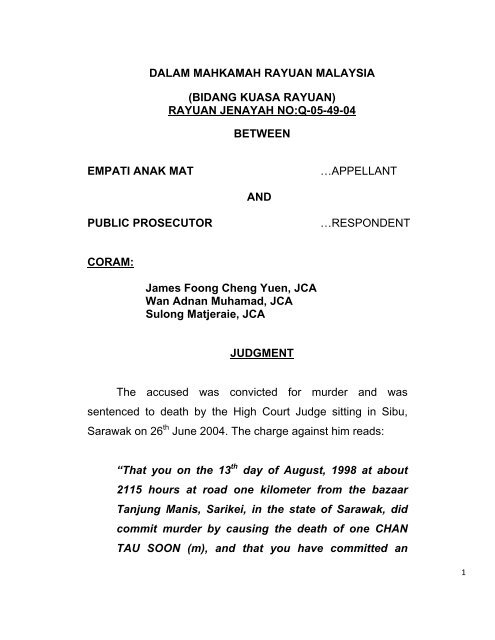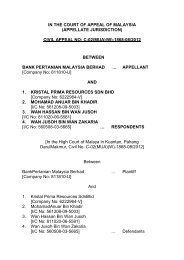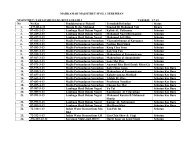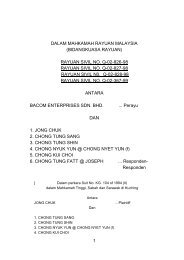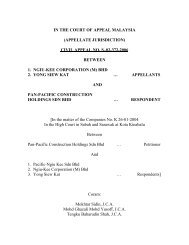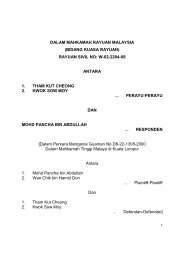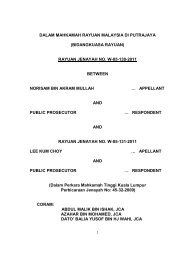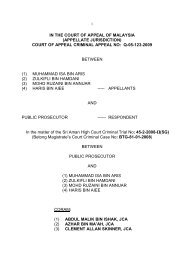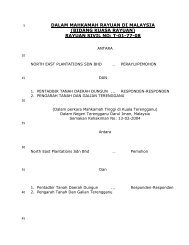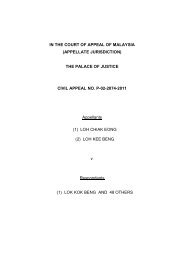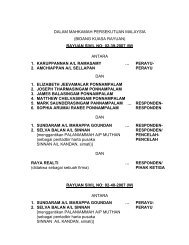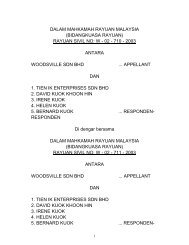rayuan jenayah no:q-05-49-04 between empati anak mat
rayuan jenayah no:q-05-49-04 between empati anak mat
rayuan jenayah no:q-05-49-04 between empati anak mat
Create successful ePaper yourself
Turn your PDF publications into a flip-book with our unique Google optimized e-Paper software.
DALAM MAHKAMAH RAYUAN MALAYSIA<br />
(BIDANG KUASA RAYUAN)<br />
RAYUAN JENAYAH NO:Q-<strong>05</strong>-<strong>49</strong>-<strong>04</strong><br />
BETWEEN<br />
EMPATI ANAK MAT …APPELLANT<br />
AND<br />
PUBLIC PROSECUTOR …RESPONDENT<br />
CORAM:<br />
James Foong Cheng Yuen, JCA<br />
Wan Adnan Muhamad, JCA<br />
Sulong Matjeraie, JCA<br />
JUDGMENT<br />
The accused was convicted for murder and was<br />
sentenced to death by the High Court Judge sitting in Sibu,<br />
Sarawak on 26 th June 20<strong>04</strong>. The charge against him reads:<br />
“That you on the 13 th day of August, 1998 at about<br />
2115 hours at road one kilometer from the bazaar<br />
Tanjung Manis, Sarikei, in the state of Sarawak, did<br />
commit murder by causing the death of one CHAN<br />
TAU SOON (m), and that you have committed an<br />
1
offence punishable under section 302 of the Penal<br />
Code”.<br />
The facts are extracted from the learned trial judge<br />
ground of judgment. On 13.8.1998 at about 9.00 pm Chan Tau<br />
Soon (the deceased) and Fook Kong Min (PW6) were travelling<br />
on a motorcycle belonging to one Teo Tia Tsim (PW5) along a<br />
road leading to Tanjung Manis bazaar from the Jaya Fuda<br />
factory at Tanjung Manis, Sarikei. The deceased was riding the<br />
motorcycle while Fook Kong Min (PW6) was riding pillion. While<br />
on their journey, PW6 heard a sound, which he described as<br />
“phiang”. On enquiring from the deceased what the sound<br />
was, and being told “<strong>no</strong>thing”, PW6 requested the deceased<br />
to stop. On stopping, the deceased complained to the PW6 of<br />
feeling numb in his right hand and then of unbearable pain<br />
before collapsing. PW6 then sought help from a passing motor-<br />
cyclist, Samuel ak William Jackson (PW7) who went to Tanjung<br />
Manis and returned with a police vehicle driven by Constable<br />
Hellery ak Tampang (PW8), together with a<strong>no</strong>ther motor-cyclist<br />
Arman bin Hussaini (PW9). The deceased was put into the<br />
police vehicle and taken to the Tanjung Manis clinic, where he<br />
was attended to by the Hospital Assistant there, Mohamad Ali<br />
Fauzi bin Hassan (PW10), who testified that when the<br />
deceased was brought in at about 9.30 pm on 13.8.1998, he<br />
was unconscious with undetectable blood pressure but had a<br />
slow pulse rate. PW10 applied an intrave<strong>no</strong>us drip to the<br />
2
deceased’s left hand and requested that he be transferred to<br />
the Sarikei Hospital.<br />
According to the PW6, the incident took place along a<br />
stretch of tarred road where there were <strong>no</strong> shops or residential<br />
houses, only bushes on either side of the road. PW6 said that<br />
when he and the deceased left Jaya Fuda factory that night, it<br />
was drizzling.<br />
Dr Nelson Yap Chie Chong (PW3), the Medical Officer at<br />
Sarikei Hospital testified that on 13.8.1998 at about 10.30 pm,<br />
he examined a young man of chinese descent at the Accident<br />
and Emergency department of the hospital. PW3 concluded<br />
that the person he examined was brought in dead due to<br />
gunshot wounds because there were <strong>no</strong> vital signs from the<br />
deceased, <strong>no</strong> pulse rate, <strong>no</strong> blood pressure, <strong>no</strong> cardial<br />
monitoring and neurological reflexes. PW3 observed 6 bullet<br />
wounds over the body: 3 to the lateral side of his right arm and<br />
3 other through and through wounds.<br />
On 14.8.1998 an autopsy was conducted at the mortuary<br />
of the Sarikei Hospital, on the person PW3 had seen the night<br />
before. The autopsy was conducted by Dr. Myint Soe (PW22) a<br />
pathologist attached to the Sibu Hospital, while PW3 assisted<br />
him. Inspector Mohd Azmi (PW11) was also present during the<br />
3
autopsy. Before the autopsy was performed, the body of the<br />
deceased was identified to all present by Lim Kok Peng (PW4),<br />
who was the uncle of the deceased.<br />
According to PW22 as a result of his external and internal<br />
examinations of the deceased, he found that severe chest<br />
injury with massive bleedings from gunshot wound caused by 2<br />
pellets to the chest was sufficient in the ordinary course of<br />
nature to cause death of the deceased. PW22`s testimony<br />
regarding the cause of the deceased’s death was <strong>no</strong>t seriously<br />
challenged in the cross-examination.<br />
On 14.8.1998 at about 2.00 am, Corporal Mahmud @<br />
Hamdan bin Majidin (PW1) received a report about the death of<br />
the deceased from Teo Tia Taim (PW5) vide Tanjung Manis<br />
Rpt/36/98). At about 9.00 am on the same day PW24 went to<br />
the scene of the incident with a few police personnel and PW6.<br />
He prepared a sketch plan (P24(A)) and took photographs of<br />
the scene.<br />
In the vicinity of the crime scene, PW24 <strong>no</strong>ticed foot-<br />
prints leading to and from a spot some 10 meters off the left<br />
side of the road, which PW24 believed to be the “ambush<br />
position” where the person who shot the deceased lay in wait.<br />
However, the mud-blocks with the accused’s foot imprint were<br />
4
<strong>no</strong>t produced as exhibits at the trial because according to<br />
PW24 the mud blocks dried and cracked, causing the outline of<br />
the foot prints to be lost, but before the mud block cracked<br />
photos were taken of them, which photos were produced as<br />
exhibits P21(L), (M),(N) and (O). The police continued their<br />
investigation to trace the suspect in the murder of the<br />
deceased. The police made a search and inquiry in all the<br />
villages and factories in the vicinity area of the incident.<br />
On16.8.1998, two shot guns were seized from Rumah<br />
Jugah, which belong to one Tawan and Mat <strong>anak</strong> Gabong<br />
(DW5); the accused’s father.<br />
On 21.8.1998 at about 3.00 p.m, while at Tanjung Manis<br />
police station, PW24 received an a<strong>no</strong>nymous telephone call<br />
from a member of public about an Iban father asking a teacher<br />
what will be the punishment could be imposed on his son who<br />
had mistakenly shot someone and had informed him that the<br />
son had disfigured lip. After receiving the said call PW24 did<br />
initial investigation at Rumah Jugah, and found out that DW5`s<br />
son had disfigured lip. On the same day, the police party went<br />
to Rumah Jugah and subsequently the accused was arrested.<br />
5
On 29.8.1998, the cautioned statement of the accused<br />
(P19) was recorded by ASP Jackson @ George Johem<br />
(PW15). When the prosecution sought to adduce the contents<br />
of P19 as evidence, the defence objected to its admissibility on<br />
the ground that it was <strong>no</strong>t given voluntarily. After trial within a<br />
trial the trial Judge admitted P19.<br />
On 30.8.1998, based on infor<strong>mat</strong>ion in P19, PW24 and<br />
police party brought the accused to the crime scene. At the<br />
scene, the accused pointed out to PW24 how he had made his<br />
way to, and left the ambush position, after the shooting. PW24<br />
then prepared sketch plan (P25 (A) & (B)), and photographs<br />
were taken (P17 (a)-(g)). From the scene, the accused was<br />
brought to Rumah Jugah. The accused showed the police<br />
where he kept the shotgun and the cartridges after the incident<br />
on the night of 13.8.1998. A search list (P26) was prepared by<br />
PW24 and a copy issued to Mat <strong>anak</strong> Gabong.<br />
On 11.9.1998, Lau Cheng Siew @ Low Cheng Siew<br />
(PW2) the chemist did firing 3 rounds on the cartridges seized<br />
by the police from Rumah Jugah using exhibit P11(a). PW2<br />
made a comparison on the characteristic mark with those<br />
cartridges marked exhibit P9 (a) and P10 (a) and found them to<br />
be similar.<br />
6
In relation to the shot gun (P11(a)) which PW2 had<br />
examined, although the shot gun was <strong>no</strong>t in good condition he<br />
found it serviceable and managed to test fire all the 3 rounds<br />
using the same shot gun.<br />
In summary, what the accused said in P19 was that on<br />
the day before the incident ( 12.8.1998 ), he was sending his<br />
younger brother to school at about 7.00 am when he met a<br />
former class<strong>mat</strong>e named Kusaimi bin Kawi who jeered him<br />
about his ugly looks. The accused said he was deeply hurt by<br />
Kusaimi’s jeering which had been going on since their school<br />
days and so he decided to teach him a lesson for what he had<br />
done all this time. The accused said that on 13.8.1998 he<br />
decided to kill Kusaimi bin Kawi by ambushing him along a road<br />
leading to Tanjung Manis town. So at about 6.00 pm on the<br />
same day he took a shot gun owned by his father and departed<br />
from his longhouse on a motorcycle and headed for the road<br />
leading to Tanjung Manis town. According to him when he<br />
took the shot gun, his parents were <strong>no</strong>t at home. On arrival at<br />
the place he selected, the accused said he hid his motorcycle<br />
at the road side then made his way to a spot some 20 feet<br />
away from the road side, where he took up an ambush position<br />
and loaded the shot gun with one of 3 cartridges he was<br />
carrying. According to the accused, Kusaimi usually went to<br />
Tanjung Manis town every night and the accused was able to<br />
recognize the light and sound of the motorcycle Kusaimi<br />
7
frequently used. The accused said that it was dark and drizzling<br />
that night and that several motorcycle passed by his ambush<br />
position but from the sound of their engines he knew it was <strong>no</strong>t<br />
Kusaimi’s. The accused said that at about 9.00 pm he saw and<br />
heard 2 motorcycles heading towards Tanjung Manis. He<br />
recognized the sound of the second of the two motorcycles<br />
which was travelling behind as that used by Kusaimi, so he<br />
waited until Kusaimi’s motorcycle was opposite him before he<br />
fired and shot in the direction of his target. The accused said he<br />
then observed the rider of the motorcycle fell down about 20<br />
feet from where he had fired his shot. The accused said that on<br />
moving forward a little from his ambush position he heard<br />
voices speaking in Chinese from the spot where the motorcycle<br />
had fallen. It was then he realized that he might have<br />
mistakenly shot someone else. He said he did <strong>no</strong>t go to check<br />
on that person as he was frightened. Instead, he made his way<br />
back to his longhouse (Rumah Jugah). On arrival back at the<br />
longhouse <strong>between</strong> 10.00 pm and 11.00 pm, the accused said<br />
he found his father fast asleep. He then put back the shot gun<br />
in the room where it was kept by his father. He also put back<br />
the cartridges and empty casing where they were kept by his<br />
father. The next day (14.8.1998) he overheard people talking<br />
about a person who had been shot dead the previous night. He<br />
then confided and told his father that on the previous night he<br />
had shot someone, <strong>no</strong>t on purpose but by mistake.<br />
8
I am satisfied that the trial Judge after holding a trial<br />
within trial held that the accused’s cautioned statement (P19)<br />
had been given voluntarily and without compulsion or<br />
inducement. When the main trial resumed, the accused’s<br />
cautioned statement was admitted into evidence through the<br />
recording officer; ASP George Joehem (PW15).<br />
During the hearing of the accused’s appeal before this<br />
court his counsel Mr.Baru Bian contended that the trial Judge<br />
had erred in deciding that the accused’s cautioned statement<br />
(P19) was given voluntarily.He said the accused is an Iban and<br />
the Recording Officer (RO) is a Bidayuh. And there was <strong>no</strong><br />
evidence that the RO was fluent in iban language. Mr. Bian<br />
urged this court to ig<strong>no</strong>re P19 because according to him even<br />
though accepted, is of little value; it was Kusaimi bin Kawi that<br />
the accused intended to shoot.<br />
Mr. Bian further submitted that the accused also<br />
emphatically denied that the statement was given voluntarily<br />
when he signed P19. He said that the accused in his<br />
testimony, pointed out that it was his signature appearing at<br />
bottom left of the pages in P19 but the accused was asked to<br />
sign on those without being told of the purposes for signing.<br />
According to Mr. Bian the accused was told to sign on exhibit<br />
PI9 because he was promised by TWTPW3 that he would be<br />
9
eleased immediately. Mr. Bian said the accused was<br />
handcuffed and wearing only his underwear, without any shirt<br />
or trousers and was barefooted when he was brought before<br />
the police officer to whom he gave his statement. Mr. Bian<br />
urged this court to look at the accused’s testimony during<br />
examination in chief.<br />
Upon perusal of the grounds of judgment I find that the<br />
trial Judge had considered the issue of voluntariness and the<br />
alleged oppressive circumstances (page 681 of the Appeal<br />
Record). Therefore I am <strong>no</strong>t going to disturb his finding of facts<br />
as they were appropriately dealt. In his ruling (page 340 of the<br />
Appeal Record) the trial judge said that the handcuffs were<br />
removed from the accused`s hands at a point in time before he<br />
gave his statement remained intact and unaffected. It is my<br />
view that the learned judge made his finding of fact. See<br />
Francis Antonysamy v. PP [20<strong>05</strong>] 3 MLJ 389); In Juraimi<br />
Husin v. PP [1998] 2 CLJ 383, it was held that:<br />
“A statement made under s.113 of the Criminal Procedure<br />
Code should be made voluntarily and the burden lies<br />
upon the prosecution to prove the voluntariness of such<br />
statement beyond a reasonable doubt, the test applicable<br />
being partly objective and partly subjective. Once a<br />
confession based on such a statement is admitted, a<br />
10
conviction may be based solely on its strength. However,<br />
as a <strong>mat</strong>ter of practice and prudence, the court ought to<br />
look for corroboration of the incriminating parts of the<br />
confession. On the facts of the case, there was <strong>no</strong>thing<br />
improper in the manner in which the statement of the first<br />
appellant was recorded by the officer in charge of the<br />
investigations. The statement was therefore made<br />
voluntarily – the product of a free mind, untainted by any<br />
illegiti<strong>mat</strong>e pressure.”<br />
Mr. Bian further contended that the trial Judge had erred<br />
in his finding that there was sufficient evidence to prove that<br />
the injuries sustained by the deceased were caused by the<br />
accused and in admitting the evidence of a a<strong>no</strong>nymous caller<br />
implicating the accused’s father, as this is a hearsay evidence.<br />
This a<strong>no</strong>nymous caller never testified at the trial to corroborate<br />
what the Investigating Officer (PW24) had said on the <strong>mat</strong>ter.<br />
For this, adverse inference must be drawn against the<br />
prosecution under s.114 (g) Evidence Act 1950, for failing to do<br />
so.<br />
Mr. Bian also drew attention to the evidence of the PW24<br />
that three days after the incident, PW24 had seized two shot<br />
guns from Rumah Jugah, one of which (P11(a)) belonged to<br />
the Appellant’s father, Mat <strong>anak</strong> Gabong (DW5). P11(a) was<br />
11
already in police custody when PW24 received the a<strong>no</strong>nymous<br />
call on 21.8.1998, about an iban father with a son with a<br />
disfigured lip, making enquiries from a teacher about what the<br />
punishment could be if his son had mistakenly shot someone. It<br />
was this infor<strong>mat</strong>ion that led to the arrest of the accused and to<br />
the subsequent cautioned statement given by the accused.<br />
On the above issue the learned trial judge in his judgment<br />
said that, the accused led the police party to the 2 nd room<br />
occupied by his parents in Rumah Jugah and retrieved three<br />
cartridges, two of which spent (P9(a) and P10(a)). The<br />
accused told the police party that of the two cartridges, he had<br />
used the rusty cartridge (P9(a)) to shoot the deceased. Both<br />
exhibits were sent to the Chemistry Department at Kuching for<br />
examination. The evidence of the Chemist (PW2), confirmed<br />
that P9(a) and P10(a) were fired from P11(a). PW2 also<br />
testified that the two pellets (which were sent to him in a bottle<br />
in envelope (E2)) were shot gun pellets of shot size ‘SG’.<br />
PW22 testified that he recovered these two pellets from the<br />
deceased’s chest during the autopsy. I also feel that this is a<br />
finding of facts by the learned trial judge.<br />
Regarding the a<strong>no</strong>nymous call which PW24 received, the<br />
learned trial judge said it was <strong>no</strong>t possible for the prosecution to<br />
produce the caller as a witness. The prosecution did <strong>no</strong>t seek to<br />
12
ely on it to prove the truth of the statement, but the fact that it<br />
was made. As such the learned trial judge was of the opinion<br />
that it was <strong>no</strong>t a case in which adverse inference might be<br />
drawn against the prosecution under s.114 (g) Evidence Act<br />
1950. My view is that the learned trial judge did <strong>no</strong>t misdirect<br />
himself on this issue.<br />
In Pang Chee Meng v. PP [1992] 1 MLJ 137, Abdul<br />
Hamid Omar LP said at page 140 regarding the said section 27<br />
as follows:<br />
“The rationale behind this section revolves on the<br />
basis that if a fact is actually discovered in consequence<br />
of infor<strong>mat</strong>ion given by the accused in custody some<br />
degree of guarantee is afforded thereby that the<br />
infor<strong>mat</strong>ion was true and accordingly can be safely<br />
allowed to be given in evidence overriding the Criminal<br />
Procedure Code and other written law.”<br />
In this case, the fact discovered concerns the place from<br />
where the spent cartridge that was used to shoot the deceased<br />
which was produced and the accused`s k<strong>no</strong>wledge of that fact,<br />
and the infor<strong>mat</strong>ion supplied by the accused relating distinctly<br />
to the fact thereby discovered was the infor<strong>mat</strong>ion about which<br />
cartridge had been used by the accused to shoot the deceased<br />
13
and where the accused had put the spent cartridge on his<br />
return to Rumah Jugah.<br />
The evidence adduced by the prosecution pointed<br />
irresistibly to the conclusion that the two pellets recovered from<br />
the deceased’s body did come from one of the two cartridges.<br />
The admission of the accused that he had used one of those<br />
cartridges (rusty cartridge) (P9(a)) to shoot the deceased; that<br />
he had used his father’s shot gun (P11(a)) to fire the cartridge;<br />
that he fired the shot gun at the deceased at the crime scene<br />
on the night in question; that the pathologist (PW22) recovered<br />
the two shot gun pellets from the deceased’s body; that the<br />
Chemist (PW2) confirmed that the said pellets which he<br />
examined were shot gun pellets and were fired from P11(a)<br />
which he found serviceable. All the evidence above, tended to<br />
confirm and corroborate what the accused had said in his<br />
cautioned statement about how the injuries came to be<br />
sustained by the deceased, therefore sufficiently proved that<br />
the deceased died as a result of the injuries he sustained were<br />
caused or was the result of the act of the accused.<br />
The learned trial Judge had sufficiently considered the<br />
accused’s cautioned statement (P19). He opined that in order<br />
to constitute the offence of murder, the intention to kill that must<br />
be proved is <strong>no</strong>t necessarily an intention to kill an identified<br />
14
person, it is sufficient if an actual intention to kill a human being<br />
is proved (Ismail bin Hussin v PP [1953] 19 MLJ 48; PP v<br />
Sainal Abidin Mading [1998] 3 CLJ 41). What was required is<br />
that the prosecution has to prove that the accused intended to<br />
cause death of the deceased. Since intention concerns the<br />
state of mind of a person, its existence is to be deduced from<br />
the evidence.<br />
Reverting to the evidence that has been adduced in the<br />
present case, it showed that on the night in question the<br />
accused had set out from his longhouse taking with him his<br />
father’s shot gun. He then selected an ambush position along a<br />
straight stretch of the road, and then waited until he was sure<br />
that the person he wanted to shoot had arrived at his ambush<br />
position before taking aim to discharge the shot-gun at his<br />
target. The irresistible inference is that his intention was to<br />
cause death to that other person.<br />
The accused also had said that he came to realize that he<br />
may have mistakenly shot the wrong person because when he<br />
moved closer to the spot where he saw the rider of the<br />
motorcycle fall, he heard voices speaking in chinese. As a<br />
<strong>mat</strong>ter of fact the deceased and his pillion rider Fook Kong Min<br />
(PW6) are chinese. The deceased and PW6 had conversed<br />
with each other before the deceased collapsed. While the<br />
accused said in his cautioned statement that on the day after<br />
15
the shooting he had heard people talking about someone being<br />
shot, he did <strong>no</strong>t say that he heard that it was a chinese was<br />
shot dead. Unless the accused had been at the scene on the<br />
night of the 13.8.1998, he would <strong>no</strong>t have the k<strong>no</strong>wledge that<br />
the voices he heard were speaking in chinese so as to enable<br />
him to suspect that he had shot the wrong person.<br />
According to the learned trial judge (page 714 of the<br />
Appeal Record), “the fact that the accused had said he wanted<br />
to kill Kusaimi bin Kawi, while it may provide a purpose or<br />
reason for the accused being at the scene of crime that night,<br />
and the fact that Kusaimi bin Kawi does <strong>no</strong>t k<strong>no</strong>w the accused,<br />
does <strong>no</strong>t in any way detract from the fact that the accused had<br />
an actual intention to kill a human being that night. Whether it<br />
was Kusaimi bin Kawi or it was Emran bin Husaini (PW13)<br />
whom the accused wanted to kill, the circumstances<br />
surrounding the shooting of the deceased, shows that the<br />
accused had an actual intention to kill a human being that night.<br />
And the fact that the accused subsequently came to realize that<br />
he might have shot the wrong person would <strong>no</strong>t in any way<br />
negative the intention to kill a human being because section<br />
301 of the Penal Code provides that:-<br />
“If a person, by doing anything which he intends or k<strong>no</strong>ws to be<br />
likely to cause death, commits culpable homicide by causing the<br />
death of any person whose death he neither intends <strong>no</strong>r k<strong>no</strong>ws<br />
16
himself to be likely to cause, the culpable homicide committed by<br />
the offender is of the description of which it would have been if he<br />
had caused the death of the person whose death he intended or<br />
knew himself to be likely to cause.”<br />
After perusing the learned trial judge grounds of<br />
judgment, I am satisfied that he had given due considerations<br />
to all requirements under the provision of section 300 of the<br />
Penal Code. The trial judge said that the deceased has been<br />
identified as Chan Tau Soon and the deceased died as a result<br />
of injuries inflicted by the accused. The accused had the<br />
intention to cause death. I am in agreement with his finding.<br />
See Tham Kai Yan & Ors. v PP [1977] 1 MLJ 174; Kenneth<br />
Fook Mun Lee v PP [2006] 4 CLJ 359.<br />
In this appeal it is clear that P19 was admitted by the trial<br />
court after TWT proceeding and the court found it to be<br />
voluntarily made. It was admitted as a result of a finding of facts<br />
by the trial court. I am <strong>no</strong>t going to disturb P19: see Francis<br />
Antonysamy v PP [Supra]. From the evidence in P19 coupled<br />
with the circumstantial evidence given by prosecution witnesses<br />
the learned trial judge found that prima facie had been made<br />
out against the accused. Again I find that the said judge came<br />
to the right conclusion.<br />
17
For the above reasons, I am satisfied with the finding of<br />
the trial Judge that the prosecution had proved the element of<br />
‘mens rea’ of the charge against the accused, and had<br />
established a prima facie case against him and called him to<br />
enter his defence.<br />
The accused denied causing death of the deceased or<br />
murdering him on the night of the 13.8.1998. He then put<br />
forward an alibi saying that he spent that night with his father<br />
and mother as well as his auntie, uncle, grandfather and<br />
grandmother at their padi hut. The accused did <strong>no</strong>t say where<br />
he was planting padi or where the hut that he had spent that<br />
night was situated, but he said the padi fields were about 2<br />
hour boat ride from Rumah Jugah.<br />
In his defence, the accused (DW1) said that a week<br />
before he was arrested he and his father (DW5) were at padi<br />
field’s hut at a place called Semujok to plant padi. He denied<br />
his presence at the crime scene on 13.8.1998. In support of his<br />
alibi defence he called four other witnesses. They were Tuai<br />
Rumah Jugah Ak Anjai (DW2), Chiki Anak Tawan (DW3),<br />
Timah Ak Remang (DW4) and Mat Ak Gabong (DW5). They<br />
were amongst a list of 13 names given by him in his Notice of<br />
Alibi dated 14.7.1999 pursuant to section 402A of the Criminal<br />
Procedure Code.<br />
18
The learned trial judge in his lengthy and exhaustive<br />
grounds of judgment was of the opinion that the evidence of<br />
DW2, DW3, DW4 and DW5 did <strong>no</strong>t have the effect of proving,<br />
supporting, corroborating or establishing in any way the alibi of<br />
the accused. He said the evidence show that the longhouse folk<br />
of Rumah Jugah, including the accused’s family own padi fields<br />
at Semujok and Menjawan which is situated quite far from their<br />
longhouse, which they would plant-up with wet padi in August<br />
of each year. Their evidence also shows that when they went to<br />
their farms, they would stay there overnight, but there is <strong>no</strong><br />
conclusive evidence about how long they would remain at their<br />
fields, usually until their food rations ran out which usually<br />
lasted for about one week. But there was also evidence that<br />
even after 2 or 3 days at the farm, the longhouse folks would<br />
return to their longhouse if the need arose. With regard to the<br />
crucial date of 13.8.1998, the trial judge found that the evidence<br />
of DW2, DW3, DW4 and DW5 whether individually or together<br />
as a whole, was unable to establish that the accused was at his<br />
padi field on that date. According to the learned judge all of<br />
them are the accused’s relatives staying in the same Rumah<br />
Jugah.<br />
According to learned trial judge for the defence of alibi,<br />
the accused only needs to establish his alibi on a balance of<br />
probabilities, (Dato’ Mohktar Bin Hashim & A<strong>no</strong>r v. PP [1983]<br />
19
2 MLJ 232). After having considered all the evidence relating<br />
to his alibi, the learned trial judge found that the accused has<br />
failed to establish that on the night of 13.8.1998, he was at his<br />
padi field but at Semujok. He rejected the accused`s defence of<br />
alibi.<br />
On the submission by Mr. Bian that the trial Judge had<br />
erred in <strong>no</strong>t accepting the evidence of the defence’s witnesses<br />
i.e DW2, DW3, DW4 and DW5 on the balance of probability as<br />
credible to prove, support, corroborating or establishing the<br />
defence of alibi, I feel they are devoid of merit. The learned trial<br />
Judge in assessing the accused’s credit at the end of the case<br />
for the defence, including what the accused had said in his re-<br />
examination, had found that the accused had <strong>no</strong>t been able to<br />
explain the <strong>mat</strong>erial contradictions <strong>between</strong> what was stated in<br />
his cautioned statement (P19) and his evidence in court and<br />
that his credits stands impeached. There was <strong>no</strong> conclusive<br />
evidence that what he said about him being at the padi hut on<br />
the <strong>mat</strong>erial night. I am in agreement with the trial Judge when<br />
he found that what was said by DW2, DW3, DW4 and DW5<br />
whether individually or together as a whole, did <strong>no</strong>t have the<br />
effect of proving, supporting, corroborating or establishing in<br />
any way the alibi of the accused. With regard to the crucial date<br />
of the 13.8.1998 the evidence of <strong>no</strong>ne of the witnesses was<br />
able to establish that the accused was at his padi field on that<br />
date. In this case his defence of alibi failed to cast any doubt<br />
20
on the prosecution’s case. My view is that the learned trial<br />
judge was right to hold that the prosecution had proved its case<br />
beyond reasonable doubt against the accused as charged. It is<br />
my considered opinion that the trial judge did <strong>no</strong>t err in his<br />
findings.<br />
In this appeal the prosecution relied on the admission by<br />
the accused in P19 and other circumstantial evidence which the<br />
learned judge accepted. With regard to the acceptance of<br />
circumstantial evidence I would like to highlight certain<br />
authorities which our courts heavily relied time and time again.<br />
See Jayaraman & Ors v PP [1982] 2 MLJ 306; Dato’ Mohktar<br />
bin Hashim v PP [Supra]; Sunny Ang v PP [1966] 2 MLJ<br />
195; Muniandy & A<strong>no</strong>r v PP [1973] 1 MLJ 179; PP v Mohd<br />
Bandar Shah Nordin & A<strong>no</strong>r [2008] 4 CLJ 859.<br />
In Jayaraman & Ors. v PP [Supra], Suffian LP at page<br />
308 quoted Thomson CJ said in Chan Chwen Kong v PP<br />
[1962] 28 MLJ 307 as follows:-<br />
“That evidence was entirely circumstantial and what<br />
the criticism of its amounts to is this, that <strong>no</strong> single piece<br />
of that evidence is strong e<strong>no</strong>ugh to sustain conviction.<br />
That is very true. It must however be borne in mind that in<br />
cases like this, where the evidence is wholly<br />
21
circumstantial what has to be considered is <strong>no</strong>t only of<br />
each individual strand of evidence but also the combined<br />
strength of these strands when twisted together to form a<br />
rope. The real question is; is that rope strong e<strong>no</strong>ugh to<br />
hang the prisoner?<br />
At page 309 Suffian LP had this to say:-<br />
“ And there is <strong>no</strong> rule that, where the prosecution is<br />
based on circumstantial evidence, the judge must, as a<br />
<strong>mat</strong>ter of law, give further direction that the facts proved<br />
are <strong>no</strong>t only consistent with the guilt of the accused, but<br />
also as to be inconsistent with any other reasonable<br />
conclusion.”<br />
And at page 310 he stated,<br />
“In our view the irresistible conclusion test only<br />
seems to place on the prosecution a higher burden of<br />
proof that in a case where it depends on direct evidence,<br />
for in fact to apply the one and one only irresistible<br />
conclusion test is a<strong>no</strong>ther way of saying that the<br />
prosecution must prove the guilt of the accused beyond<br />
reasonable doubt ”<br />
22
I do <strong>no</strong>t find any misdirection by the learned trial judge on<br />
facts and on law. It is trite that an appellate court should be<br />
slow in disturbing a finding of facts by the trial judge unless<br />
such finding is clearly against the weight of evidence: per Nik<br />
Hashim FCJ at page 294 in Che Omar Mohd Akhir v PP<br />
[2007] 3 CLJ 281; see also Andy bin Bagindah v PP [2000] 3<br />
MLJ 644.<br />
With regard to the evidence of DW5 (the accused`s<br />
father) the trial judge directed his mind by giving due<br />
consideration that DW5 had used the two cartridges (P9(a))<br />
and P10(a)) to shoot wild boar and monkey with. He felt that<br />
DW5`s testimony on how the two cartridges were used was<br />
inconsistent with the evidence adduced by the prosecution. He<br />
considered DW5`s evidence with suspect as DW5 was <strong>no</strong>t<br />
independent witness.<br />
The learned trial judge rejected the accused`s defence.<br />
He gave plenty of reasons in his judgment and he reasoned<br />
out why he did <strong>no</strong>t accept the evidence of the defence<br />
witnesses. According to the trial judge`s finding the said<br />
witnesses are from the accused long house and padi field<br />
which the accused said he was at the <strong>mat</strong>erial time, is only two<br />
hour boat ride. It is his factual finding that the said witnesses`<br />
23
evidence as a whole or individually failed to establish that the<br />
accused was at his padi field on that night.<br />
The trial judge also rejected the evidence of the accused<br />
as a mere denial. After giving due considerations to whole<br />
evidence before him, he found that the defence failed to raise<br />
reasonable doubt to the prosecution`s case. He also found that<br />
the prosecution had proved its case beyond reasonable doubt.<br />
He found him guilty and convicted him. Death sentence was<br />
imposed on the accused.<br />
For all the above reasons, this court unanimously<br />
dismissed this appeal and affirmed the conviction and sentence<br />
of the trial court.<br />
My learned brothers James Foong Cheng Yuen, JCA<br />
(currently FCJ) and Sulong Matjeraie, JCA having read this<br />
judgment in draft agree with the reasons expressed herein and<br />
to the decision given in this case.<br />
t.t.<br />
(DATO’ WAN ADNAN BIN MUHAMAD)<br />
Judge<br />
Court of Appeal, Malaysia.<br />
Date: 31July, 2009<br />
24
For Appellant: Mr. Baru Bian<br />
Messrs. Baru Bian & Co. Advocates<br />
Kuching, Sarawak<br />
For Respondent: DPP Awang Armadajaya Bin Awang<br />
Mahmud<br />
Kuching, Sarawak<br />
25
Cases Referred To:<br />
1. Francis Antonysamy v PP [20<strong>05</strong>] 3 MLJ 389;<br />
2. Juraimi Husin v PP [1998] 2 CLJ 383;<br />
3. Pang Chee Meng v PP [1992] 1 MLJ 137;<br />
4. Ismail Bin Hussin v PP [1953] 19 MLJ 48;<br />
5. PP v Sainal Abidin Mading [1998] 3 CLJ 41;<br />
6. Tham Kai Yan & Ors. v PP [1977] 1 MLJ 174;<br />
7. Keeneth Fook Mun Lee v PP [2006] 4 CLJ 359;<br />
8 Dato’ Mokhtar Bin Hashim & A<strong>no</strong>r v PP [1983] 2 MLJ 232;<br />
9. Jayaraman & Ors. v PP [1982] 2 MLJ 306;<br />
10. Sunny Ang v PP [1966] 2 MLJ 195;<br />
11. Muniandy & A<strong>no</strong>r v PP [1973] 1 MLJ 179;<br />
12. PP v Mohd Bandar Shah Nordin & A<strong>no</strong>r [2008] 4 CLJ 859;<br />
13. Chan Chwen Kong v PP [1962] 28 MLJ 307;<br />
14. Che Omar Akhir v PP [2007] 3 CLJ 281;<br />
15. Andy Bin Bagindah v PP [2000] 3 MLJ 644;<br />
26


